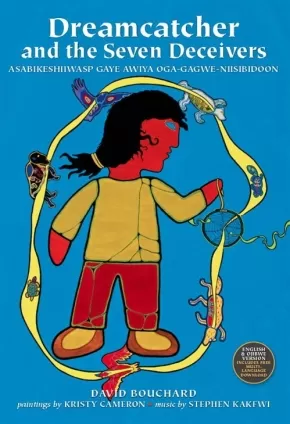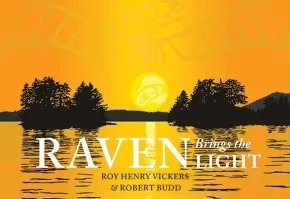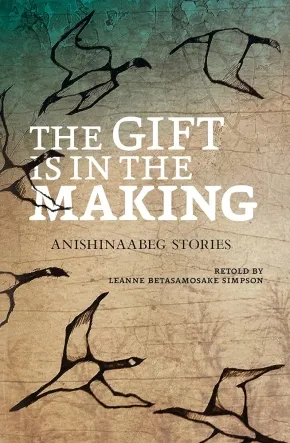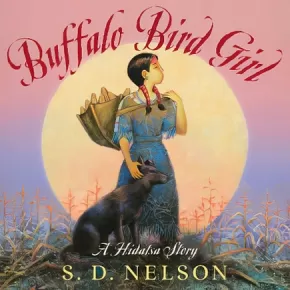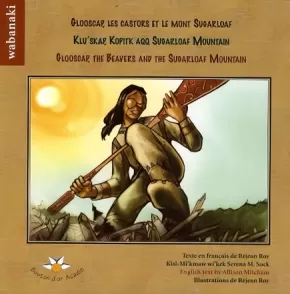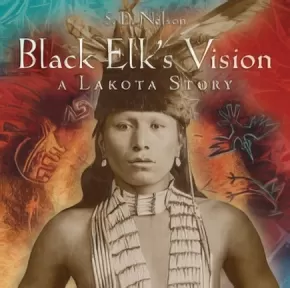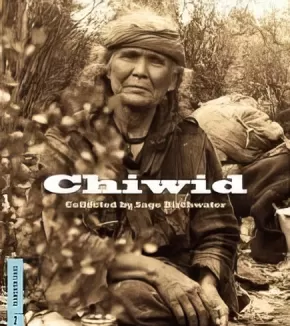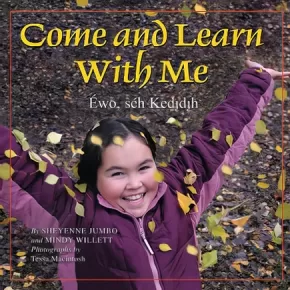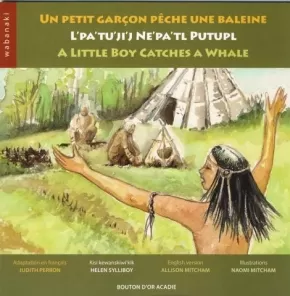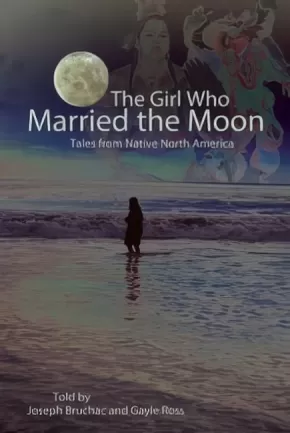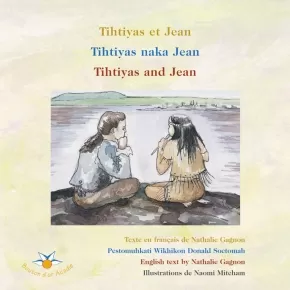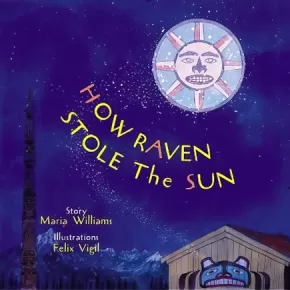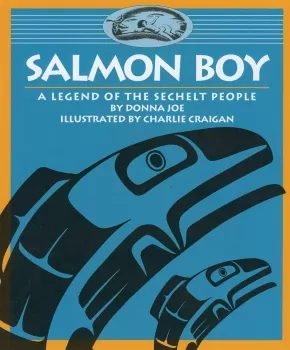
Indigenous Narratives
76
-
90
of
96 Results;
Sort By
Go To
of 7
Dreamcatcher and the Seven Deceivers
$21.95
Artists:
Format:
Hardcover
Text Content Territories:
Indigenous Canadian; First Nations; Inuit; Métis;
Grade Levels: 5;
ISBN / Barcode: 9780978432799
Synopsis:
Synopsis:
Dreamcatcher and the Seven Deceivers, the sequel to the Seven Sacred Teachings, warns of voices we can expect to hear in our dream time – voices that do not represent the Sacred Teachings.
These are the voices of Seven Deceivers who are spoken of by name. The allure of their whisperings is carefully spelled out in order that all might come to know what to listen for. Dreamcatcher and the Seven Deceivers is a carefully woven telling of how and why Creator sent Trickster to Turtle Island with a gift that would help us see the light and resist temptation. At a time before distant religions and churches came with their teachings, their commandments and their seven cardinal sins, we knew. We knew the way of the Good Red Road. We knew the right way to live; not through commandments but through Sacred Teachings – Teachings that were given to us long before their arrival. And we knew we would be tested by Seven Deceivers – what they called seven cardinal sins. We knew because we had been forewarned. And when these distant churches arrived with their teachings, their relics and their symbols, we had our own. One was the Dreamcatcher.
Rooted in humility and honesty, the creators have tried to respect the cultures and traditions of all peoples. It is our hope that this telling will unite and thus heal divisions. Prophecies tell that this is the time for One Heart, One Mind and One Drum. We, readers and authors alike, are the ones we have been waiting for. There is nobody else who can revitalize our culture and values except ourselves.
It is our hope that this telling might move readers toward greater courage and wisdom and ultimately toward achieving and understanding what is true in life’s journey.
The Seven Sacred Teachings are a link that ties all Native, Inuit and Métis communities together.
Educator Information
Available in French HERE!
Additional Information
35 pages
Raven Brings the Light
$24.95
Format:
Hardcover
Text Content Territories:
Indigenous Canadian; First Nations; Tsimshian (Ts'msysen); Haida;
ISBN / Barcode: 9781550175936
Synopsis:
Synopsis:
In a time when darkness covered the land, a boy named Weget is born who is destined to bring the light. With the gift of a raven's skin that allows him to fly as well as transform, Weget turns into a bird and journeys from Haida Gwaii into the sky. There he finds the Chief of the Heavens who keeps the light in a box. By transforming himself into a pine needle, clever Weget tricks the Chief and escapes with the daylight back down to Earth.
Vividly portrayed through the art of Roy Henry Vickers, Weget's story has been passed down for generations. The tale has been traced back at least 3,000 years by archeologists who have found images of Weget's journey in petroglyphs on the Nass and Skeena rivers. This version of the story originates from one told to the author by Chester Bolton, Chief of the Ravens, from the village of Kitkatla around 1975.
Reviews
"One of the great problems we face today is our sense of isolation and separateness from the rest of the world. Roy Henry Vickers' art constantly reminds us of the interconnectedness of everything in the world. With this magnificent book, he shows us our interdependence physically and spiritually. It is a message we have to hear." — David Suzuki, environmental activist, broadcaster, author
Educator & Series Information
This book is part of the Northwest Coast Legends Series.
Other books in this series include:
Raven Brings the Light
Cloudwalker
Orca Chief
Peace Dancer
Recommended for ages 3 to 6.
Additional Information
40 pages | 12.00" x 8.25"
The Gift is in the Making: Anishinaabeg Stories
$22.00
Format:
Paperback
Text Content Territories:
Indigenous American; Native American; Anishinaabeg;
ISBN / Barcode: 9781553793762
Synopsis:
Synopsis:
The Gift Is in the Making retells previously published Anishinaabeg stories, bringing to life Anishinaabeg values and teachings to a new generation. Readers are immersed in a world where all genders are respected, the tiniest being has influence in the world, and unconditional love binds families and communities to each other and to their homeland. Sprinkled with gentle humour and the Anishinaabe language, this collection of stories speaks to children and adults alike, and reminds us of the timelessness of stories that touch the heart.
Educator & Series Information
This book is part of The Debwe Series.
Recommended for grades 5 to 9.
Additional Information
99 pages | 5.50" x 8.50"
Buffalo Bird Girl: A Hidatsa Story
$28.99
Artists:
Format:
Hardcover
Text Content Territories:
Indigenous American; Native American; Three Affiliated Tribes; Hidatsa;
ISBN / Barcode: 9781419703553
Synopsis:
Synopsis:
"I was born in an earth lodge by the mouth of the Knife River, in what is now North Dakota, three years after the smallpox winter." - Buffalo Bird Woman
Born in the 1830s, Buffalo Bird Girl was a member of the Hidatsa people, a Native American community that lived in permanent villages along the Missouri River on the Great Plains. Like other girls her age, Buffalo Bird Girl learned the ways of her people through watching, listening and then doing. She helped plant crops in the spring, tended the fields through the summer - scaring off birds and other animals, as well as hungry boys! - and in autumn joined in the harvest. She also learned to prepare animal skins, dry meat and perform other household duties. Along with her chores, however, there was time for playing games with friends or training her dog. Her family also visited the nearby trading post, where all sorts of magnificent things from the white man's settlements in the East could be seen.
Interweaving the actual words and stories of Buffalo Bird Woman with his artwork and archival photographs, award-winning author and artist S.D. Nelson has woven a poignant yet vibrant story, beautifully capturing the spirit of Buffalo Bird Girl and her lost way of life. The book includes a historical timeline.
Reviews
"The extraordinary illustration of this handsome volume begins with the endpaper maps and features acrylic paintings of the Hidatsa world reminiscent of traditional Plains Indian art. Pencil drawings and relevant, carefully labeled photographs round out the exquisite design. All the artwork both supports and adds to the text. An extensive author’s note and timeline supplement this beautiful tribute." —Kirkus Reviews, starred review
"Nelson's quiet, respectful tone capably balances the factual details of daily life in the Hidatsa tribe with the obvious joy and nostalgia Buffalo Bird Girl feels toward her childhood." —The Bulletin of the Center for Children's Books
"As a writer, storyteller, and traditional artist of the Sioux people, his perspective is genuine and effectively portrayed. This book would be enjoyable for anyone interested in history, but would also be an effective resource in the classroom to support the curriculum.”—Library Media Connection
"Nelson's acrylic paintings and b&w pencil drawings are intriguingly interlaced with the photographs, contrasting Native American figures in blunt profile with harvest colors and background textures that mimic dried spears of grass, leather skins, and basket weaves." — Publishers Weekly"
Educator Information
This fascinating picture book biography tells the childhood story of Buffalo Bird Woman. Through her true story, readers will learn what it was like to be part of this Native American community that lived along the Missouri River in the Dakotas, a society that depended more on agriculture for food and survival than on hunting. Children will relate to Buffalo Bird Girl’s routine of chores and playing with friends, and they will also be captivated by her lifestyle and the dangers that came with it.
Recommended Ages: 6-10
Additional Information
56 pages | 10.50" x 10.25"
Glooscap, the Beavers and the Sugarloaf Mountain
$8.95
Artists:
Format:
Paperback
Text Content Territories:
Indigenous Canadian; First Nations; Mi'kmaq;
Grade Levels: 4;
ISBN / Barcode: 9782896820054
Synopsis:
Synopsis:
After creating the Mi’kmaqs, the great Glooscap was certain that he had established harmony on earth. But a problem remained: the beavers had built a huge dam across the Restigouche River, preventing the salmon from swimming upriver as far as the camp of the Mi’kmaqs who had come to fish there. Young Mi’kmaq men were convinced they could remedy the situation. However, completely failing to put things right, they asked the loon to call Glooscap to help them. Will the beavers once more outmaneuver Master Glooscap?
Educator Information
Delivered in a triple-language format of English, French, and Mi'kmaw.
Roy has written his version of a Mi’kmaq legend in this story, mentioning special places such as Sugarloaf Mountain.
French Text: Rejean Roy
English Text: Allison Mitcham
Kisi-Mi'kmaw wi'kek Text: Serena M. Sock
Illustrations: Rejean Roy
Additional Information
22 pages | 8.00" x 8.00"
A Stranger at Home: A True Story
$12.95
Editors:
Format:
Paperback
Text Content Territories:
Indigenous Canadian; Inuit; Inuvialuit (Mackenzie Inuit);
ISBN / Barcode: 9781554513611
Synopsis:
Synopsis:
The powerful memoir of an Inuvialuit girl searching for her true self when she returns from residential school.
Traveling to be reunited with her family in the Arctic, 10-year-old Margaret Pokiak can hardly contain her excitement. It's been two years since her parents delivered her to the school run by the dark-cloaked nuns and brothers.
Coming ashore, Margaret spots her family, but her mother barely recognizes her, screaming, "Not my girl." Margaret realizes she is now marked as an outsider.
And Margaret is an outsider: she has forgotten the language and stories of her people, and she can't even stomach the food her mother prepares.
However, Margaret gradually relearns her language and her family's way of living. Along the way, she discovers how important it is to remain true to the ways of her people -- and to herself.
Highlighted by archival photos and striking artwork, this first-person account of a young girl's struggle to find her place will inspire young readers to ask what it means to belong.
Sequel to Fatty Legs.
Reviews
"This memoir, detailing a woeful piece of Canadian history and demonstrating Margaret's strength of character, compassion, courage and her willingness to sacrifice herself for her family's sake, gives the reader a lot to ponder. Highly recommended." — Shelbey Krahn, Canadian Materials, February 2012
"A Stranger at Home will speak to anyone who has experienced displacement or assimilation into a new culture. This fabulous story enhances the Grades 6 to 8 social studies curriculum." — Professionally Speaking (Ontario College of Teache, April 2012
"While it may not have the same drama and tension of the first memoir, this tale provides a compelling and moving story of a girl searching for the strength to find her place in the world." — Jody Kopple, School Library Journal, December 2011
"Without being graphic or overwhelming, the Fentons recreate a tragic moment in Canadian history through the innocent reflections of a child...a must for any classroom library." — Canadian Teacher Magazine, May 2012
"This tale provides a compelling and moving story of a girl searching for the strength to find her place in the world. The writing is unpretentious and accessible and readers who enjoyed the first book will find this an interesting follow-up. Vivid paintings are a beautiful accompaniment to the storytelling. Photographs from Pokiak Fenton's own collection add important points of reference for readers looking to visualize the characters and the unique setting of the Arctic Circle. A welcome addition to biography collections." — Jody Kopple, School Library Journal, December 2011
Educator Information
Recommended Ages: 9-13.
Guided Reading Level: Fountas and Pinnell U
Themes: biography; Inuit; Indigenous peoples; arctic; residential schools; identity; community; Canadian content; family; society; history; memoir.
This resource is also available in French: Étrangère chez moi
Additional Information
128 pages | 6.25" x 9.00"
Black Elk's Vision: A Lakota Story
$27.95
Artists:
Format:
Hardcover
Text Content Territories:
Indigenous American; Native American; Sioux; Lakota; Oglala Lakota;
ISBN / Barcode: 9780810983991
Synopsis:
Synopsis:
Told from the Native American point of view, Black Elk’s Vision provides a unique perspective on American history. From recounting the visions Black Elk had as a young boy, to his involvement in the battles of Little Big Horn and Wounded Knee, as well as his journeys to New York City and Europe with Buffalo Bill’s Wild West Show, this biographical account of Black Elk—an Oglala-Lakota medicine man (1863–1950)—follows him from childhood through adulthood.
S. D. Nelson tells the story of Black Elk through the medicine man’s voice, bringing to life what it was like to be Native American in the mid-to-late nineteenth century and early twentieth century. The Native people found their land overrun by the Wha-shi-choos, or White Man, the buffalo slaughtered for sport and to purposely eliminate their main food source, and their people gathered onto reservations. Through it all, Black Elk clung to his childhood visions that planted the seeds to help his people—and all people—understand their place in the circle of life. The book includes archival images, a timeline, a bibliography, an index, and Nelson’s signature art.
Reviews
“A fine choice for story hours, this will also find wide curricular use.” —Booklist
“A modern-day story in the Sioux tradition of storytelling.” —Winston-Salem Journal
“Splendid acrylic artwork captures the action, humor, and spirit of the tale. A solid addition to collections of Native American tales and an enjoyable read-aloud.” —School Library Journal
“Nelson pulls it off with his confident style as a storyteller . . . polished illustrations . . . informative, well written.” —Kirkus Reviews
Educator Information
F&P level: U
F&P genre: B
Additional Information
48 pages | 10.50" x 10.37"
Chiwid
$19.00
Format:
Paperback
Text Content Territories:
Indigenous Canadian; First Nations; Dene; Tsilhqot'in (Chilcotin);
ISBN / Barcode: 9780921586395
Synopsis:
Synopsis:
Chiwid was a Tsilhqot'in woman, said to have shamanistic powers, who spent most of her adult life "living out" in the hills and forests around Williams Lake, BC. Chiwid is the story of this remarkable woman told in the vibrant voices of Chilcotin oldtimers, both native and non-native.
Reviews
"Chiwid was a Chilcotin woman who lived outside, self-sufficiently for most of her life and moving camps with the seasons. Chiwid is a collection of oral histories about the woman, her family and what life was like in the Chilcotin area of British Columbia in the early to mid-1900s." - The Association of Book Publishers of BC. BC Books for BC Schools. 2009-2010.
Additional Information
128 pages | 8.00" x 9.00"
Authenticity Note: This book's author is not Indigenous; however, the book has the Authentic Indigenous Text label because it contains stories collected by the author from Indigenous and non-Indigenous peoples. It is up to readers to determine if this book will work as an authentic text for their purposes.
Come and Learn With Me: Ewo, seh Kedjdjh
$19.95
Artists:
Format:
Hardcover
Text Content Territories:
Indigenous Canadian; First Nations; Dene;
ISBN / Barcode: 9781897252574
Synopsis:
Synopsis:
Nine-year-old Sheyenne lives in Sambaa K'e, Northwest Territories-that's Trout Lake in English. Come learn with her as she takes you on a journey to her community in the fall, the season of moose.
This is the fourth book in the popular series "The Land Is Our Storybook" and features the Dehcho region of the Dene. "The Land Is Our Storybook" is a series of books about the lands and cultures of Canada's Northwest Territories. In the books, storytellers, elders, and cultural leaders from the ten regions in the Territories share real stories of everyday life in the North today.
Reviews
"The non-fiction book is colorful with rich, brilliant photographs and maps. Well-organized . . . Intriguing facts are contained within this book, making it a valuable resource for in classrooms, libraries, and homes. Come and Learn With Me can be used with both Aboriginal and non-Aboriginal readers to learn about Trout Lake's daily life during the fall moose season. This book will help preserve and keep the Dene Yatie (used to be known as South Slavey) group's language and culture alive. It is an innovative teaching tool and a 'must have' to read." — CM magazine
"Readers would be hard pressed to find a book of better quality whether it be for information, text, illustrations, layout, photography, or overall presentation. The text is well written and informative. The text is enhanced by maps, glossary, sidebars, graphics and stunning photography." — Resource Links
Educator & Series Information
This book is part of the "The Land Is Our Storybook" series, which considers the diverse lands and cultures of Canada's Northwest Territories. Told in a uniquely diverse range of northern voices, with a child-centred approach, books in the series highlight each official Aboriginal language group in the NWT, revealing a richly textured picture of life in the North -- on the trapline, around the campfire, in communities, at school, and within the outdoor school that is the land itself. The series celebrates the seasons, ages, genders, traditional activities, and communities of the NWT.
The stories are illustrated by the striking images of acclaimed northern photographer, Tessa Macintosh and depict the similarities in lifestyle between children of the North and South, as well as the marked cultural differences, and highlight the special relationship these First Nations people have with the land and how they are adapting to rapid change while remaining connected to the land. Images of the landscape and animals within it, of trapping, hunting, fishing, and bannock baking sit alongside pictures of children at school, swimming at recreation centres, and reading in libraries. Here is modern northern culture painted beautifully: a complex mix of the new and the old.
These wonderful books, written with a variety of provincial and territorial curricula in mind, are specially designed for the classroom and include special features such as glossaries relating details on animals biology and cultural definitions, regional and language maps. The text of the stories also have sidebars such as Our Stories, which contain the stories of the people and language group featured, and Our Words, which highlight words in the featured language that are important to the story.
This resource is also available in French: Viens avec moi: Nous apprendrons ensemble!
Additional Information
32 pages | 8.00" x 8.00" | colour photographs and illustrations, map
A Little Boy Catches a Whale
$7.95
Format:
Paperback
Text Content Territories:
Indigenous Canadian; First Nations; Mi'kmaq;
Grade Levels: 3;
ISBN / Barcode: 9782922203493
Synopsis:
Synopsis:
One late fall day, the boy told the old people that he was going fishing. When he returned home, he said that he had caught a whale.
Un matin, juste avant l’arrivée de l’hiver, le garçon dit à ses parents qu’il part à la pêche. Peu de temps après, il revient chez lui, tout heureux d’annoncer qu’il a pêché une baleine.
Educator & Series Information
This book is delivered in a triple-language format of English, French, and Mi'kmaq.
This book is part of Collection Wabanaki.
How the Petitcodiac River Became Muddy
$9.95
Artists:
Format:
Paperback
Text Content Territories:
Indigenous Canadian; First Nations; Mi'kmaq;
ISBN / Barcode: 9782922203813
Synopsis:
Synopsis:
How the Petitcodiac River Became Muddy is a trilingual picture book that retells a Mi'kmaq legend.
This simple story details the Mi'kmaq explanation for an eclipse, why the lobster turns red when it is put in boiling water, and how the Petitcodiac River became muddy long ago. This legend draws on the original version by Michael Francis (1923-1995) of Elsipogtog, New Brunswick. Glooscap figures prominently in this remarkable story that is recommended for language programs.
Educator & Series Information
The French title is Comment la riviÞre Petitcodiac devint boueuse. The Mi'kmaq title is Ta'n Tel-kisi-siskuapua'qsepp Petikotiak Sipu. Allison Mitcham tells the English version. Serena Sock provides the Mi'kmaq translation, and Marguerite Maillet provides the French translation. The dynamic art illustrations are created by Raymond Martin.
This book is part of Collection Wabanaki.
Additional Information
22 pages | 8.00" x 8.00"
The Girl Who Married the Moon
$18.95
Format:
Paperback
Text Content Territories:
Indigenous American; Native American;
ISBN / Barcode: 9781555915667
Synopsis:
Synopsis:
This collection of traditional stories explores the significance of a young girl's rite of passage into womanhood. Each of these stories originated in the oral tradition and have been carefully researched. Joseph Bruchac, author of the best-selling Keeper's of the Earth series, and noted storyteller, has been entrusted with stories from elders of other native nations which ensures that the stories collected in The Girl Who Married the Moon are authentic.
The book is broken into four sections, signifying the importance of the number four to Native peoples, and provides an opportunity to hear from a wide variety of Native American tribal nations. These nations have offered to share their stories with their blessing, to celebrate the traditional ways.
Tihtiyas and Jean (1 in stock, in reprint)
$8.95
Artists:
Format:
Paperback
Text Content Territories:
Indigenous Canadian; First Nations; Passamaquoddy (Peskotomuhkati);
Reading Level: N/A
ISBN / Barcode: 9782922203745
Synopsis:
Synopsis:
Tihtiyas and Jean is a trilingual picture book that retells a Passamaquoddy legend and also introduces the idea of contact with the French.
The French title is Tihtiyas et Jean. The English and French translation are provided by Nathalie Gagnon. The Passamaquoddy title is Tihtiyas naka Jean and is translated by Donald Soctomah.
The main character is a 12-year-old Passamaquoddy girl named Tihtiyas. She lives with her extended family near the mouth of the Schoodic River. One day she retells her younger brother the traditional story about Glooscap and Wuchowsen, the Wind-blower. This story explains why the waters are never too rough or too calm when the people fish. While telling this story both children see something in the distance that reminds them of the Wind-blower. They are amazed to see a large boat with white sails approaching the shore. From the boat, men with strange appearance come ashore and speak in a language they do not understand. This marks the contact period between the Passamaquoddy and the French. The girl meets a youth, named Jean, about her age and they share their love of music with each other. The French find themselves without much food and extreme illness over the winter as they settled on Muttoneguis Island (Saint Croix). But their neighbours the Passamaquoddy arrive to bring medicine and nourishing food.
This is a unique story that explores the contact period from the perspective of First Nation children. It also introduces young readers to the Passamaquoddy language.
Educator Information
This book is delivered in a triple-language format of English, French, and Passamaquoddy.
Additional Information
34 pages | 8.00" x 8.00"
How Raven Stole the Sun (Tales of the People)
$21.95
Artists:
Format:
Hardcover
Text Content Territories:
Indigenous American; Alaska Native; Tlingit;
ISBN / Barcode: 9780789201638
Synopsis:
Synopsis:
A long time ago, Raven was pure white, like fresh snow in winter. This was so long ago that the only light came from campfires, because a greedy chief kept the stars, moon, and sun locked up in elaborately carved boxes. Determined to free them, the shape-shifting Raven resourcefully transformed himself into the chief's baby grandson and cleverly tricked him into opening the boxes and releasing the starlight and moonlight. Though tired of being stuck in human form, Raven maintained his disguise until he got the chief to open the box with the sun and flood the world with daylight, at which point he gleefully transformed himself back into a raven. When the furious chief locked him in the house, Raven was forced to escape through the small smokehole at the top--and that's why ravens are now black as smoke instead of white as snow.
This engaging Tlingit story is brought to life in painted illustrations that convey a sense of the traditional life of the Northwest Coast peoples.
Additional Information
32 pages | 9.50" x 9.60"
Salmon Boy
$12.95
Artists:
Format:
Paperback
Text Content Territories:
Indigenous Canadian; First Nations; Salish; Coast Salish; Shishalh (Sechelt);
ISBN / Barcode: 9780889711662
Synopsis:
Synopsis:
In Salmon Boy: A Legend of the Sechelt People, a young boy is captured by a Chum salmon and brought to the country of the salmon people-a dry land beneath water where "the salmon people walked about the same as people do above the sea." The boy lived with them for one year, and his captivity becomes a source of learning that will ensure the survival of his own people.
After accompanying the salmon people on their run, the Sechelt boy hops out of the river and returns home to teach everything he has learned to his people who, from that time forward, treat the salmon properly and always have enough to eat. The salmon people, now respected by the humans, happily "give their rich flesh to feed the people of the land."
This beautiful story is accompanied by black and white illustrations of the boy and his adventures. Though written especially for children, Salmon Boy, with its simple message of responsibility and respect, will appeal to all ages.
Educator Information
Simple and compelling First Nations drawings illustrate this dynamic story that teaches respect for the environment and describes the life cycle of the salmon.
Series Information
This book is part of the Legends of the Sechelt Nation series.
Additional Information
24 pages | 7.00" x 8.50"
Sort By
Go To
of 7

